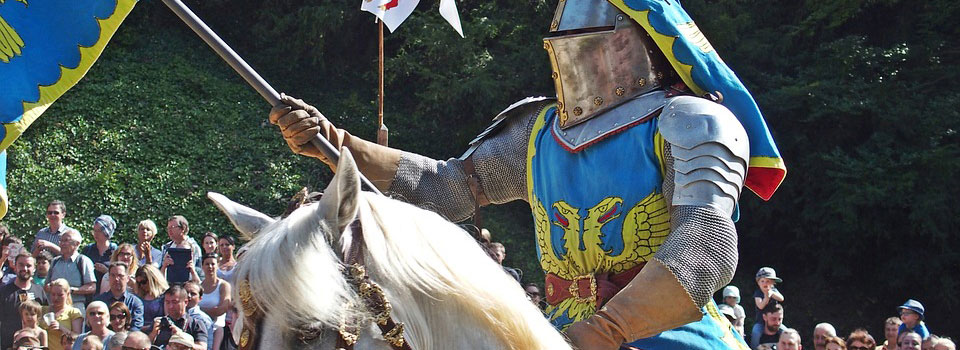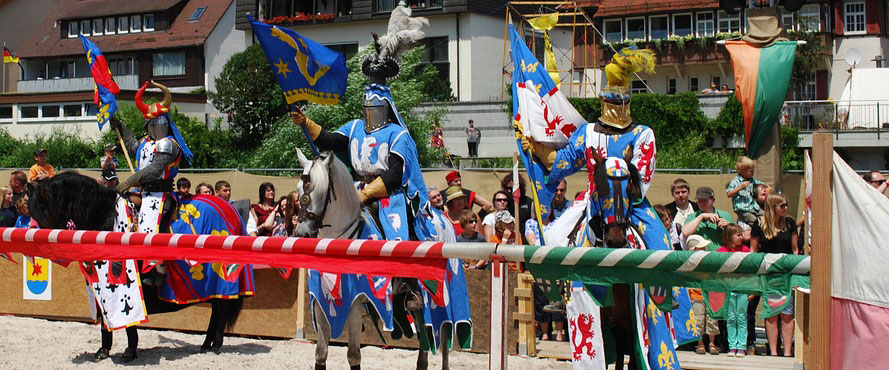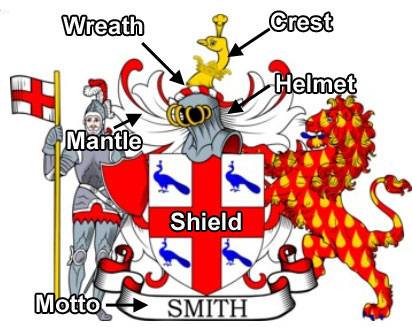TKnights



Connection Between Knights and a Coat of Arms
A coat of arms is a distinctive and unique heraldic design that you will find on an escutcheon (i.e. a shield), a surcoat (loose outer coat or gown), or a tabard (tunic or cape garment).

The different components of a coat of arms therefore were arms that were displayed on surcoats.
Arms were not just worn!
These coats of arms could also be found on banners throughout the middle ages, as well as a horse’s bardings, (the armor and trappings put on horses).
The word escutcheon can be used as a metaphor for a family’s honor. There are a number of different shapes of shield, such as the common heater style (modern medieval French and English), modern French, cartouche (oval), and lozenge or diamond (usually borne by woman).
Identifying each other!
In medieval times knights would use a coat of arms to identify themselves. During competitions an announcer, (a herald), would introduce the knights.
The crowd could distinguish a knight by the design that was emblazoned on his shield, helmet and armor.
The coat of arms thus signified all of a knight’s achievements and the impressive battle gear that he wore. Because of this it evolved into a status symbol.
Inheriting a Coat of Arms
In the beginning these coat of arms were only worn by people of great nobility. But with the passage of time they were worn by people of lesser nobility and knights.

So, if you are wondering about a coat of arms for your family’s name then I am about to disappoint you.
Unfortunately there is no such thing as a coat of arms for a surname.
The coat of arms was for one man, just to identify himself in battle. But a coat of arms can be used by genealogists to prove a family connection.
Different types of inheriting a coat of arms
Cadency
A son could inherit his father’s shield but would have to alter it slightly. This tradition of adding to the design was known as cadency.
Following the father’s death however the son’s coat of arms would revert back to that of his father’s.
Marshalling
This was the merging of two families coat of arms due to marriage. Through this tradition you may find more than one design within the center of the arms, (the shield).
Women Bearing Arms
A woman could bear arms and this would take the form of a lozenge or diamond shape. This would show the shield of her father.
If the woman was married then she could display the arms of her husband.
Granting A Coat of Arms
To have your very own coat of arms you must be granted one. These can only be granted by the respective Kings of Arms in England, Scotland and Northern Ireland.
There is a College of Arms which accounts for all the different designs of coats of arms. People within the United States, Australia and Sweden can also apply to register for a coat of arms.
6 Parts of the Coat of Arms
There are six parts that make up the coat of arms. The first part is the shield, which will you find at the center of the design.

Do not get confused though as the shield and the five other parts you can also find on a knight’s shield that was used in battle.
1. The Shield
A knight would place various elements onto his shield such as a lion, bear or an eagle. Different colors could also be used to identify an individual.
The different shield shape could represent a geographical origin and time period.
2. The Helm or Helmet
This indicates a rank. So if the helm was gold then this would signify royalty, or if it was a steel helmet with a closed visor then this would denote a gentleman.
3. The Crest
This was another form of identifying a knight that was later adopted. Elements commonly used include feathers, leather or wood.
4. The Mantle or Mantling
This was used to seal a knight from the sun and also to protect him from the rain. This was essentially a piece of cloth that was placed over the helmet and would drape down the back of the base of the helm.
One side would typically be similar to the main colors of the coat of arms design, while the other side would either be white or yellow.
5. The Wreath
This part would cover the join between the crest and the helmet. This would typically be two silken scarves that were twisted.
The colors used would be the first named metal and the first named color in the blazon. These were known as the colors.
6. The Motto
This is not essentially a part of a coat of arms but is generally seen together. A motto is a phrase that describes a family’s philosophy or denotes an ancient war cry.
These are normally found below the coat of arms or sometimes above the crest. (Example above shows the family name).




